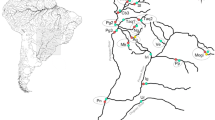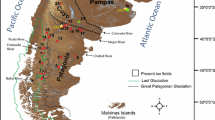Abstract
We analyzed 11 microsatellite loci to determine the genetic population structure of saugers and to describe the amount and pattern of hybridization with widely introduced walleyes in the upper Missouri River drainage. We detected significant genetic differentiation among saugers spawning upstream and downstream of the confluence of the Bighorn and Yellowstone Rivers. Samples from upstream of the confluence had significantly lower heterozygosity and allelic richness. We suspect this reflects isolation at the periphery of the species’ range and possibly genetic drift resulting from recent population contractions due to dams, diversions, and water development. We detected only eighteen hybrids out of 925 individuals analyzed. Hybridization appeared recent, as nearly 50% of the hybrids showed significant evidence for having a non-hybrid ancestor within two generations. All but one hybrid were detected in the Yellowstone River drainage, despite a substantially higher rate of walleye stocking in the Missouri River drainage, suggesting conditions in the Yellowstone may be more conducive to hybridization. Rarity of hybridization is unexpected, given both massive walleye releases and previous findings of more frequent hybridization in the study area. Introgression of walleye genes into native saugers does not appear to be an immediate threat.




Similar content being viewed by others
References
Allendorf FW, Leary RF, Spruell P, Wenburg JK (2001) The problem with hybrids: setting conservation guidelines. Trends Ecol Evol 16:613–622. doi:10.1016/S0169-5347(01)02290-X
Amadio CJ, Hubert WA, Johnson K, Oberlie D, Dufek D (2005) Factors affecting the occurrence of saugers in small, high-elevation rivers near the western edge of the species’ natural distribution. Trans Am Fish Soc 134:160–171. doi:10.1577/FT03-225.1
Araki H, Schmidt C (2010) Is hatchery stocking a help or harm? Evidence, limitations and future directions in ecological and genetic surveys. Aquac 308:S2–S11. doi:10.1016/j.aquaculture.2010.05.036
Baxter GT, Stone MD (1995) Fishes of Wyoming. Wyoming Game and Fish Department, Cheyenne
Belgraph BJ, Guy CS, Gardner WM, Leathe SA (2008) Competition potential between saugers and walleyes in nonnative sympatry. Trans Am Fish Soc 137:790–800. doi:10.1577/T07-102.1
Billington N, Hebert DN, Ward RD (1988) Evidence of introgressive hybridization in the genus Stizostedion: interspecific transfer of mitochondrial DNA between sauger and walleye. Can J Fish Aquat Sci 45:2035–2041. doi:10.1139/f88-237
Billington N, Brooks RC, Heidinger RC (1997) Frequency of natural hybridization between saugers and walleyes in the Peoria Pool of the Illinois River, as determined by morphological and electrophoretic criteria. N Am J Fish Manag 17:220–224. doi:10.1577/1548-8675(1997)017<0220:FONHBS>2.3.CO;2
Billington N, Koigi RN, Sloss BL, Frankowiak RP, Xiong J (2006) Genetic variation and hybridization with walleye in Montana sauger populations determined by protein electrophoresis and microsatellite analysis. Report to Montana Fish, Wildlife & Parks, Helena
Boecklen W, Howard DJ (1997) Genetic analysis of hybrid zones: numbers of markers and power of resolution. Ecology 78:2611–2616. doi:10.1890/0012-9658(1997)078[2611:GAOHZN]2.0.CO;2
Boyer MC, Muhlfeld CC, Allendorf FW (2008) Rainbow trout (Oncorhynchus mykiss) invasion and the spread of hybridization with native westslope cutthroat trout (Oncorhynchus clarkii lewisi). Can Fish Aquat Sci 65:658–669. doi:10.1139/F08-001
Carlson J (2003) Montana animal species of special concern. Montana Natural Heritage Program and Montana Fish, Wildlife & Parks, Helena
Carufel LH (1963) Life history of saugers in Garrison Reservoir. J Wildl Manag 27:450–456
Eldridge WH, Bacigalupi MD, Adelman IR, Miller LM, Kapuscinski AR (2002) Determination of relative survival of two stocked walleye populations and resident natural-origin fish by microsatellite parentage DNA assignment. Can J Fish Aquat Sci 59:282–290. doi:10.1139/f02-007
Epifanio J, Philipp D (2001) Simulating the extinction of parental lineages from introgressive hybridization: the effects of fitness, initial proportions of parental taxa, and mate choice. Rev Fish Biol Fish 10:339–354. doi:10.1023/A:1016673331459
Falush D, Stephens M, Pritchard JK (2003) Inference of population structure using multilocus genotype data: linked loci and correlated allele frequencies. Genetics 164:1567–1587
Fiss FC (1997) Reproduction among saugeyes (FX hybrids) and walleyes in Normandy Reservoir, Tennessee. N Am J Fish Manag 17:215–219. doi:10.1577/1548-8675(1997)017<0215:RASFHA>2.3.CO;2
Gangl RS, Pereira DL, Walsh RJ (2000) Seasonal movement, habitat use and spawning areas of walleyes Stizostedion vitreum and saugers S. canadense in Pool 2 of the upper Mississippi River. Minnesota Department of Natural Resources Investigation Report 482, St. Paul
Gardner WM, Stewart PA (1987) The fishery of the lower Missouri River, Montana. Montana Department of Fish, Wildlife & Parks, Report FW-2-R, Helena
Goudet J (2001) FSTAT, a program to estimate and test gene diversities and fixation indices Version 2.9.3. www.unil.ch/izea/softwares/fstat.html
Graeb BDS, Willis DW, Billington N, Koigi RN, VanDeHey JA (2010) Age-structured assessment of walleyes, saugers, and naturally produced hybrids in three Missouri River reservoirs. N Am J Fish Manag 30:887–897. doi:10.1577/M09-091.1
Guo SW, Thompson EA (1992) A Monte Carlo method for combined segregation and linkage analysis. Am J Hum Genet 51:1111–1126
Hearn MC (1986) Reproductive viability of sauger-walleye hybrids. Prog Fish-Cult 48:149–150. doi:10.1577/1548-8640(1986)48<149:RVOSH>2.0.CO;2
Hedrick PW (2005) A standardized genetic differentiation measure. Evolution 59:1633–1638. doi:10.1111/j.0014-3820.2005.tb01814.x
Hickley P (1993) Stocking and introduction of fish—a synthesis. In: Cowx IG (ed) Rehabilitation of freshwater fisheries. Blackwell, Oxford, pp 247–254
Jaeger ME, Zale AV, McMahon TE, Schmitz BJ (2005) Seasonal movements, habitat use, aggregation, exploitation, and entrainment of saugers in the lower Yellowstone River: an empirical assessment of factors affecting population recovery. N Am J Fish Manag 25:1550–1568. doi:10.1577/M04-158.1
Johnson BL, Smith DL, Carline RF (1988) Habitat preferences, survival, growth, foods, and harvests of walleyes and walleye × sanger hybrids. N Am J Fish Manag 8:292–304. doi:10.1577/15488675(1988)008<0292:HPSGFA>2.3.CO;2
Kerr SJ (2008) A survey of walleye spawning activities in North America. Fish and Wildlife Branch, Ontario Ministry of Natural Resources, Report, Peterborough
Kohlman K, Kersten P (2008) Isolation and characterization of nine microsatellite loci from pike-perch Sander lucioperca (Linnaeus 1758). Mol Ecol Resour 8:1085–1087. doi:10.1111/j.1755-0998.2008.02166.x
Krueger KL, Hubert WA, White MM (1997) An assessment of population structure and genetic purity of sauger in two high-elevation reservoirs in Wyoming. J Freshw Ecol 12:499–509. doi:10.1080/02705060.1997.9663564
Kuhn KM, Hubert WA, Johnson K, Oberlie D, Dufek D (2008) Habitat use and movement patterns by adult saugers from fall to summer in an unimpounded small-river system. N Am J Fish Manag 28:360–367. doi:10.1577/M06-235.1
Laikre L, Schwartz M, Waples R, Ryman N, Genomics Working Group (2010) Compromising genetic diversity in the wild: unmonitored large-scale release of plants and animals. Trends Ecol Evol 25:520–529. doi:10.1016/j.tree.2010.06.013
Leary RW, Allendorf FW (1997) Introgression between introduced walleye and native sauger in Fort Peck Reservoir and the Yellowstone River, Montana. Report to Montana Department of Fish, Wildlife & Parks, Helena
Leary RF, Allendorf FW, Sage GK (1995) Hybridization and introgression between introduced and native fish. In: Schramm HL, Piper RG (eds) Uses and effects of cultured fishes in aquatic ecosystems. American Fisheries Society Symposium, vol 15, Bethesda, pp 91–101
Leclerc D, Wirth T, Bernatchez L (2000) Isolation and characterization of microsatellite loci in the yellow perch (Perca flavescens), and cross-species amplification within the family Percidae. Mol Ecol 9:995–997. doi:10.1111/j.1471-8286.2006.01645.x
Lesica P, Allendorf FW (1995) When are peripheral populations valuable for conservation? Cons Biol 9:753–760. doi:10.1046/j.1523-1739.1995.09040753.x
Li L, Wang HP, Givens C, Czesny S, Brown B (2007) Isolation and characterization of microsatellites in yellow perch (Perca flavescens). Mol Ecol Notes 7:600–603. doi:10.1111/j.1471-8286.2006.01645.x
Lynch WE, Johnson DL, Schell SA (1982) Survival, growth, and food habits of walleye × sauger hybrids (saugeye) in ponds. N Am J Fish Manag 4:381–387. doi:10.1577/1548-8659(1982)2<381:SGAFHO>2.0.CO;2
Malison JA, Kayes TB, Held JA, Amundson CH (1990) Comparitive survival, growth, and reproductive development of juvenile walleye and sauger and their hybrids reared under intensive culture conditions. Prog Fish-Cult 52:73–82. doi:10.1577/1548-8640(1990)052<0073:CSGARD>2.3.CO;2
McMahon TE, Gardner WM (2001) Status of sauger in Montana. Intermt J Sci 7:1–21
Miller RR, Williams JD, Williams JE (1989) Extinctions of North American fishes during the past century. Fisheries 14:22–38. doi:10.1577/1548-8446(1989)014<0022:EONAFD>2.0.CO;2
Muhlfeld CC, Kalinowski ST, McMahon TE, Taper ML, Leary RF, Allendorf FW, Painter S (2009) Hybridization rapidly reduces fitness of native trout in the wild. Biol Lett 5:328–331. doi:10.1098/rsbl.2009.0033
Nelson WR, Walburg CH (1977) Population dynamics of yellow perch (Perca flavescens), sauger (Stizostedion canadense), and walleye (Stizostedion vitreum vitreum) in four mainstem Missouri River reservoirs. J Fish Res Board Can 34:1748–1765. doi:10.1139/f77-240
Nielsen EE, Bach LA, Kotlicki P (2006) HYBRIDLAB (Version 1.0): a program for generating simulated hybrids from population samples. Mol Ecol Notes 6:971–973. doi:10.1111/j.1471-8286.2006.01433.x
Pegg MA, Betolli PW, Layzer JB (1997) Movement of saugers in the lower Tennessee River determined by radio telemetry, and implications for management. N Am J Fish Manag 17:763–768. doi:10.1577/1548-8675(1997)017<0763:MOSITL>2.3.CO;2
Penkal RF (1992) Assessment and requirements of sauger and walleye populations in the lower Yellowstone River and its tributaries. Montana Department of Fish, Wildlife & Parks, Report, Helena
Pritchard JK, Stephens M, Donnelly P (2000) Inference of population structure using multilocus genotype data. Genetics 155:945–959
Rawson MR, Scholl RL (1978) Reestablishment of saugers in Lake Erie. In: Kendall RL (ed) Selected cool water fishes of North America, vol 11. American Fisheries Society, Bethesda, pp 261–265
Raymond M, Rousset F (1995) GENEPOP (version 1.2): population genetics software for exact tests and ecumenicism. J Hered 86:248–249
Rhymer JM, Simberloff D (1996) Extinction by hybridization and introgression. Annu Rev Ecol Syst 27:83–109. doi:10.1146/annurev.ecolsys.27.1.83
Rice WR (1989) Analyzing tables of statistical tests. Evolution 43:223–225. doi:10.2307/2409177
Schwartz TS, Beheregaray LB (2008) Using genotype simulations and Bayesian analyses to identify individuals of hybrid origin in Australian bass: lessons for fisheries management. J Fish Biol 72:435–450. doi:10.1111/j.1095-8649.2007.01734.x
Scott WB, Crossman EJ (1979) Freshwater fishes of Canada. The Bryant Press, Toronto
Siegwarth GL, Summerfelt RC (1993) Performance comparison and growth models for walleyes and walleye × sauger hybrids reared for two years in intensive culture. Prog Fish-Cult 55:229–235. doi:10.1577/1548-8640(1993)055<0229:PCAGMF>2.3.CO;2
Slatkin M (1995) A measure of population subdivision based on microsatellite allele frequencies. Genetics 139:457–462
Vähä J, Primmer C (2006) Efficiency of model-based Bayesian methods for detecting hybrid individuals under different hybridization scenarios and with different numbers of loci. Mol Ecol 15:63–72. doi:10.1111/j.1365-294X.2005.02773.x
Van Zee BE, Billington N, Willis DW (1996) Morphological and electrophoretic examination of Stizostedion samples from Lewis and Clark Lake, South Dakota. J Freshw Ecol 11:339–344. doi:10.1080/02705060.1996.9664456
Weir BS, Cockerham CC (1984) Estimating F-statistics for the analysis of population structure. Evolution 38:1358–1370. doi:10.2307/2408641
Welker MT, Roberts EL, Stahl LK, Wendel J (2001) Seasonal movement, migration, and activity patterns for sauger in the Big Horn River, Wyoming. Administrative Report CY-2LB-511-01, Wyoming Game and Fish Department, Fish Division, Cheyenne
White MM, Schell S (1995) An evaluation of the genetic integrity of Ohio River walleye and sauger stocks. In: Schramm HL, Piper RG (eds) Uses and effects of cultured fishes in aquatic ecosystems. American Fisheries Society Symposium, vol 15, Bethesda, pp 52–60
White MM, Kassler TW, Philipp DP, Schell SH (2005) A genetic assessment of Ohio River walleye. Trans Am Fish Soc 134:661–667. doi:10.1577/T03-218.1
Wirth T, Saint-Laurent R, Bernatchez L (1999) Isolation and characterization of microsatellite loci in walleye (Stizostedion vitreum), and cross-species amplification within the family Percidae. Mol Ecol 8:1960–1963. doi:10.1046/j.1365-294x.1999.00778-3.x
Wright S (1951) The genetical structure of populations. Ann Eugen 15:323–354
Acknowledgments
We thank Steve Amish, Mike Backes, Ken Frazer, Bill Gardner, Paul Gerrity, Tyler Haddix, Marty Kardos, Earl Radonski, Vic Riggs, Mike Ruggles, Don Skaar, and Mark Smith for sample collection, organization, and helpful discussion. Figure 1 was provided by Emily Dixon and Adam Petersen of MTFWP. Reference walleyes were provided by Louis Bernatchez, Kim Scribner, and Matthew White. Funding for this project was provided by MTFWP and WGF.
Author information
Authors and Affiliations
Corresponding author
Rights and permissions
About this article
Cite this article
Bingham, D.M., Leary, R.F., Painter, S. et al. Near absence of hybridization between sauger and introduced walleye despite massive releases. Conserv Genet 13, 509–523 (2012). https://doi.org/10.1007/s10592-011-0303-0
Received:
Accepted:
Published:
Issue Date:
DOI: https://doi.org/10.1007/s10592-011-0303-0




